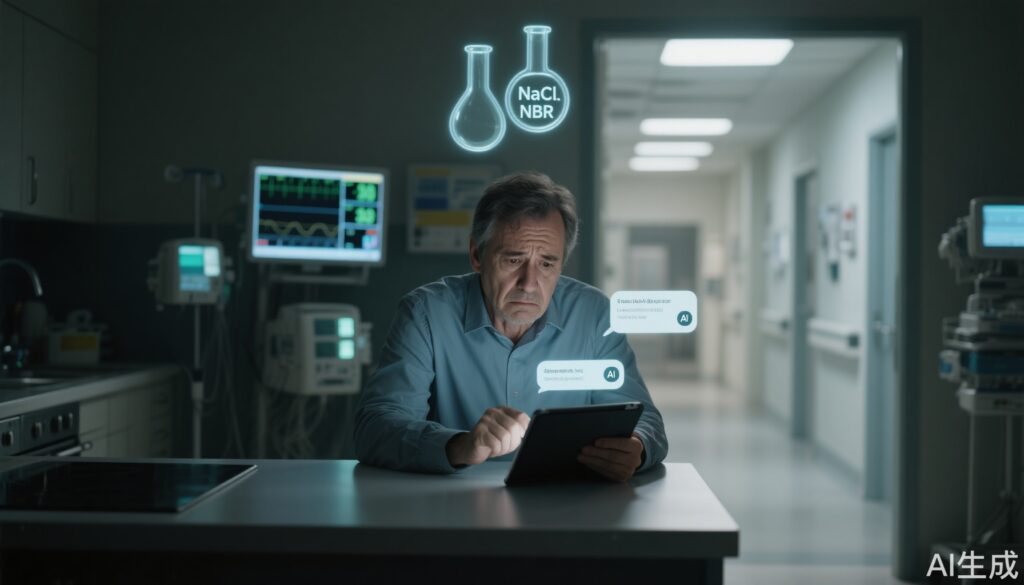Highlights
– A 60-year-old man developed neuropsychiatric symptoms and dermatologic signs after three months of replacing dietary sodium chloride with sodium bromide following advice from ChatGPT; diagnosis was bromide toxicity (bromism).
– Laboratory interference produced apparent hyperchloremia (pseudohyperchloremia); confirmatory testing for serum bromide and toxicology consultation enabled correct diagnosis.
– Management focused on stopping exposure, supportive care, enhanced elimination (saline diuresis and consideration of hemodialysis for severe cases), and psychiatric support.
– The case illustrates risks when large language models (LLMs) provide decontextualized chemical or health substitutions, and reinforces clinician vigilance for online-sourced supplement exposures and artifact-driven lab abnormalities.
Study background and disease burden
Bromide salts were historically used in medicinal and over-the-counter preparations (sedatives, anticonvulsants) during the 19th and early 20th centuries. Over time, the toxic potential of chronic bromide exposure—collectively termed bromism—became apparent and many bromide-containing preparations were removed from the market in the 1970s–1980s, resulting in a marked decline in bromism incidence in high-income countries.
Despite this, sporadic cases continue to occur, commonly associated with accidental or intentional ingestion of bromide-containing products purchased online as supplements or industrial chemicals misused as food additives. Bromide toxicity presents a clinical diagnostic challenge because manifestations are protean—neuropsychiatric (confusion, delirium, psychosis), neurologic (ataxia, weakness), dermatologic (bromoderma, acneiform eruptions), gastrointestinal, and biochemical (laboratory artifact such as pseudohyperchloremia). Underrecognition can delay appropriate management and expose patients to unnecessary psychiatric or other interventions.
The recent case reported in Annals of Internal Medicine: Clinical Cases (8 August) offers a contemporary example of how online health information and LLM outputs can influence patient behavior with clinical consequences.
Study design (case description)
This is a single-patient case report describing a 60-year-old man who, after reading about harms of dietary salt, asked ChatGPT whether chloride in salt could be substituted. The patient reported that ChatGPT suggested bromide as one possible substitute; he replaced all dietary sodium chloride (NaCl) with sodium bromide (NaBr) purchased online and consumed it for approximately three months.
He presented to an emergency department with new-onset paranoia and hallucinations. Laboratory testing showed elevated serum bicarbonate/CO2 and increased measured serum chloride with normal sodium—an unexpected combination prompting further review. Clinicians identified the pattern of pseudohyperchloremia and, after toxicology consultation and targeted testing, diagnosed bromide toxicity. Management included cessation of NaBr exposure, electrolyte monitoring and correction, psychiatric care (antipsychotics when indicated), and consideration of enhanced elimination.
As a case report, there is no comparator arm; the article serves to document presentation, diagnostic workup, and management lessons.
Key findings
Clinical presentation
– Neuropsychiatric: New-onset persecutory delusions and visual/auditory hallucinations culminating in emergency psychiatric admission.
– Neurologic and systemic: Insomnia, fatigue, impaired coordination, and persistent thirst; later improvement with psychiatric therapy and stopping exposure.
– Dermatologic: Facial acneiform eruptions and small erythematous papules consistent with bromoderma or bromide-related dermatoses.
Laboratory and diagnostic clues
– Electrolytes: Measured serum chloride was apparently elevated while sodium was normal and serum CO2/bicarbonate and total CO2 were increased (consistent with metabolic alkalosis in the clinical report). This discordance raised concern for laboratory artifact rather than true hyperchloremia.
– Pseudohyperchloremia: Bromide ions, because of their chemical similarity and interference with certain chloride assays (particularly those using ion-selective electrodes or colorimetric methods), can falsely elevate measured chloride concentrations. Such interference can produce the appearance of hyperchloremia independent of sodium changes and is a classic laboratory pitfall.
– Confirmation: Serum bromide concentration measurement (send-out testing by mass spectrometry or specialized assays) and toxicology consultation established the diagnosis.
Therapeutic interventions and outcomes
– Immediate measures: Discontinuation of NaBr ingestion and supportive inpatient care with close neurologic and electrolyte monitoring.
– Psychiatric management: Antipsychotic medication was administered because of dangerous psychosis and risk to self/others; the patient required psychiatric hospitalization when symptoms escalated.
– Enhanced elimination: Fluid resuscitation and sodium loading can promote renal bromide excretion because chloride and bromide share renal tubular handling; loop diuretics may be used to promote diuresis. In severe or refractory cases with high serum bromide and life-threatening neurologic impairment, hemodialysis effectively removes bromide and can lead to clinical improvement.
– Clinical course: With cessation of exposure and combined medical/psychiatric management, the patient’s mental status improved, enabling history-taking that revealed the role of ChatGPT and online NaBr acquisition.
Clinical significance and effect sizes
– As a single case report, numerical effect sizes and statistical inference are not applicable. However, the case demonstrates several high-yield diagnostic signals: (1) new psychiatric symptoms in an older adult with atypical skin findings and electrolyte discordance should prompt consideration of toxic exposures; (2) measured hyperchloremia with normal sodium is a red flag for assay interference (bromide); and (3) focused history (including online supplement use and AI-guided behaviors) is essential.
Safety and adverse outcomes
– Delayed recognition led to severe psychiatric decompensation requiring involuntary psychiatric admission and antipsychotic therapy. The report underscores potential harms from self-directed substitution of chemicals for food or medications without professional oversight.
Expert commentary
Diagnostic perspective
– Laboratory interference by bromide is well-documented: bromide can cross-react in chloride assays, yielding spuriously raised chloride values. Clinicians should consider bromide exposure when the measured chloride is discordant with clinical and other laboratory findings (e.g., normal sodium, anion gap discrepancies, or expected osmolality).
– Definitive diagnosis requires direct measurement of bromide concentration or toxicology consultation. Routine hospital labs do not always provide bromide assays; timely contact with toxicology/poison control and the laboratory medicine service expedites appropriate testing and avoids misinterpretation.
Pathophysiology and plausibility
– Bromide chemically resembles chloride and competes in certain biological and assay contexts. Chronic ingestion accumulates because bromide’s renal clearance is slower than chloride; the biologic half-life in humans can be on the order of days to weeks depending on renal function, hence the cumulative toxicity after months of ingestion.
Management considerations and evidence
– There are no randomized trials for bromism management; guidance comes from case reports, toxicology texts (for example, Goldfrank’s Toxicologic Emergencies), and clinical experience. Key interventions are removal of the source, supportive care, promoting renal clearance with isotonic saline and diuretics, and hemodialysis in severe cases. Psychiatric symptoms often improve with elimination of the offending agent combined with symptomatic psychotropic therapy when necessary.
AI and clinical safety implications
– This case is a cautionary example of the interface between consumer-facing AI and health behavior. Large language models can generate plausible-sounding but potentially harmful suggestions when presented with decontextualized prompts. LLMs generally lack the capacity to obtain necessary clinical context, assess risk, or provide individualized medical advice, and they may not consistently provide safety warnings.
– Developers and clinicians must both improve how AI tools are used and how users interpret outputs: LLMs should carry clear, context-sensitive disclaimers, and clinicians need to inquire about online-sourced health decisions and purchases. Health systems should incorporate patient education about the limits of AI for medical decision-making.
Limitations and generalizability
– As a single-case report, the findings are not generalizable in a statistical sense, but they are highly instructive for clinical practice. The case may under-represent the frequency of similar events because many individuals who follow online advice do not seek care or are not recognized as having toxic exposures.
Conclusion
This case of bromide toxicity after ChatGPT–guided replacement of table salt underscores several practical lessons for clinicians and health systems. New-onset neuropsychiatric symptoms in older adults—especially when accompanied by dermatologic findings and unusual electrolyte patterns—warrant a focused exposure history that includes online-sourced supplements and chemical substitutions. Laboratory discordance such as apparent hyperchloremia with normal sodium should prompt consideration of pseudohyperchloremia from halide interference, and clinicians should consult toxicology and laboratory medicine early.
From a systems perspective, the case highlights the ongoing need to educate patients about the limitations of LLMs for medical advice, to ensure clearer AI disclaimers and safety guardrails, and to integrate questions about AI-guided health decisions into routine history-taking. Toxicologic management remains pragmatic: halt exposure, supportive care, measures to enhance bromide elimination, and hemodialysis when clinically indicated.
References
1. Case report as published in Annals of Internal Medicine: Clinical Cases (8 August 2025). (Citation provided in the case prompt.)
2. Goldfrank’s Toxicologic Emergencies. New York: McGraw-Hill Education. (Authoritative toxicology textbook discussing halide toxicities and management principles.)
3. American Association of Poison Control Centers (AAPCC). Web resources and guidance on toxic exposures and poison control consultation (https://www.aapcc.org/).
Note: Clinicians seeking further detail on assay-specific interference and local lab capabilities should engage their clinical chemistry laboratory; for management of suspected bromide toxicity, consult local poison control and medical toxicology services.



